
Bathrooms need some way of exhausting air. Mostly it’s to keep the humidity down, but depending on who lives in the house, the bathroom also can be a source of a lot of volatile organic compounds (VOCs). Not all homes have bathroom exhaust fans, but let’s focus here on those that do. Ideally, these fans connect to ducts that send the air all the way to the outdoors. Not to an attic. Not to the garage. Outdoors. Have you been in your attic to see if yours goes all the way out?
Snorkeled to the attic
I’ve been in a whole lot of attics. I can tell you that a great many homes have bath fans that do NOT vent all the way to the outdoors. Let’s look at a few of the photos I’ve taken over the years.
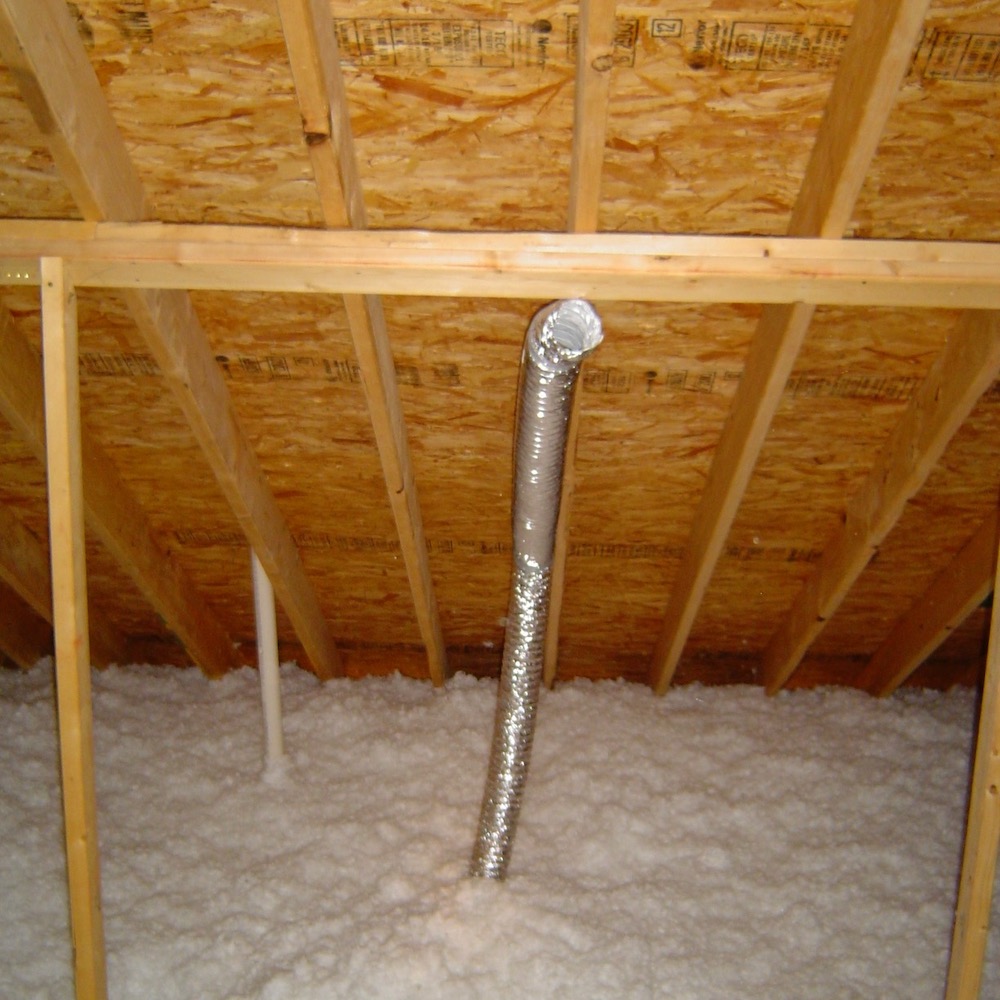
The snorkel method just dumps bathroom exhaust into the attic. The lead photo shows one coming out of the fan and aiming toward the ridge. The one directly above looks like it could be the trunk of an underwater elephant.
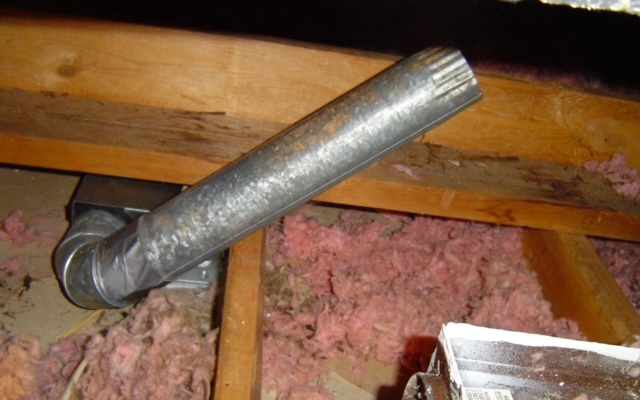
The one just above used hardpipe, which is more expensive than flex. That must be why this installer used a piece that was just barely long enough to get above the level of the attic insulation (or at least where the insulation should have been).
Close to the roof deck
When you snorkel that air into the attic, you’re putting a lot of moisture up there. This can be a significant problem in winter because the surfaces are cold. And as I’m sure you know, water vapor loves cold surfaces. And when you dump the moisture close to the roof deck, you’re more likely to have problems.
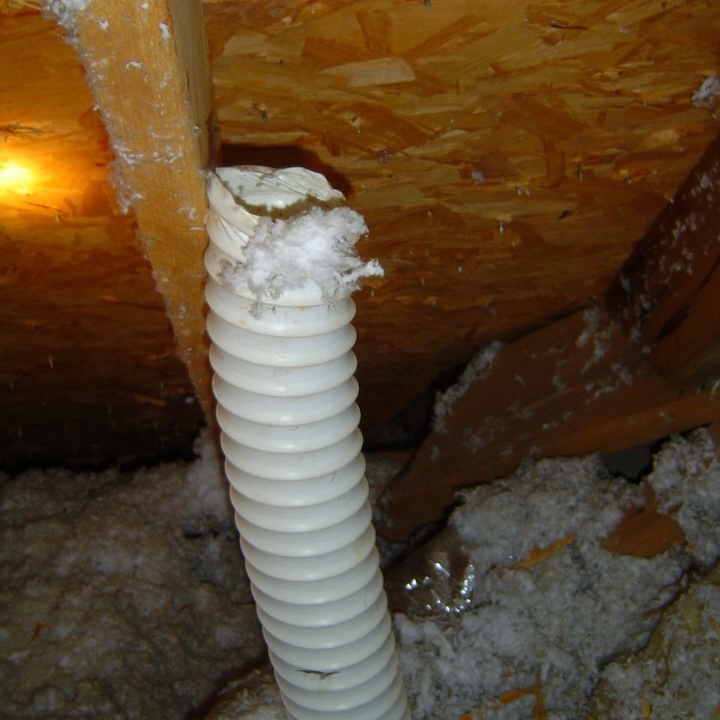
The snorkel above is close to the roof deck, but the part of the roof deck showing here doesn’t seem to have problems.
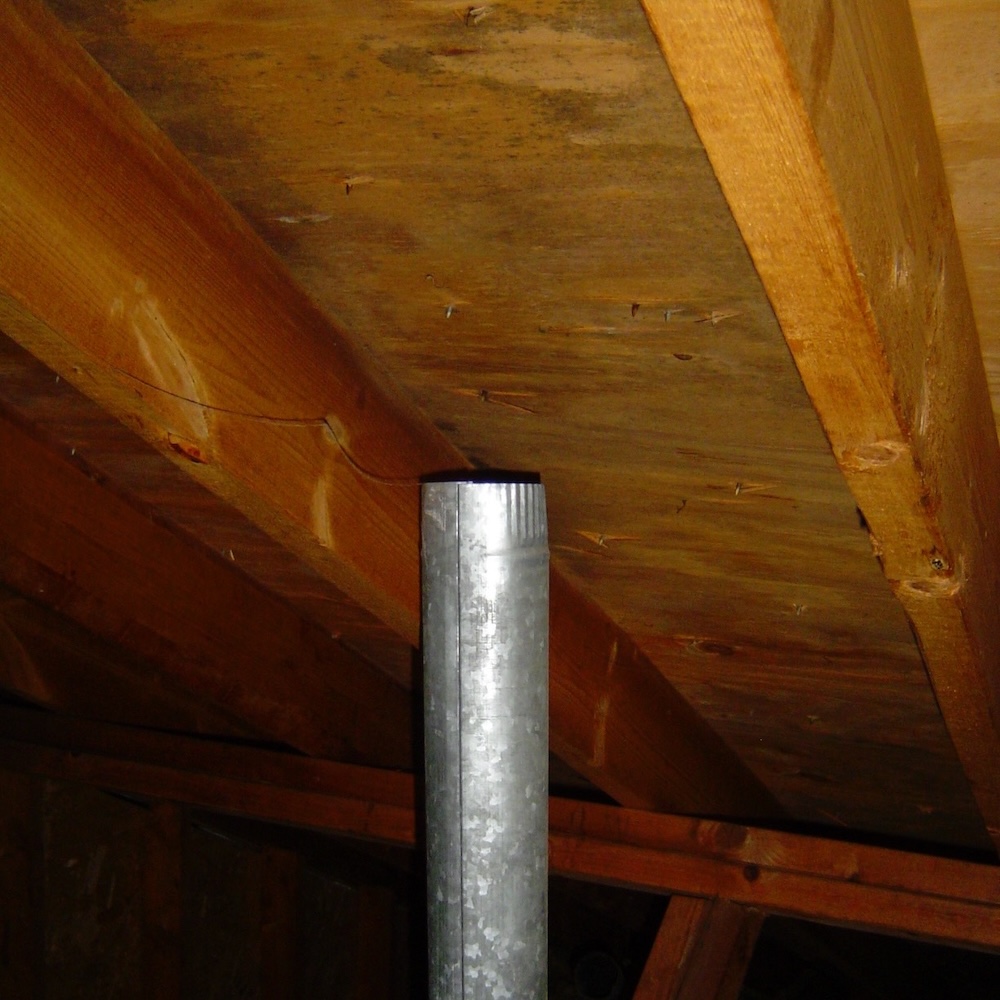
How about this one? The roof deck near that snorkel is looking kind of dark.
![A frosty attic rafter bay above a bathroom exhaust fan [Courtesy of Grant Walkin]](https://www.energyvanguard.com/wp-content/uploads/2024/01/frost-in-attic-heavy.jpg)
This problem isn’t directly due to a bath fan venting in the attic, although I believe that shiny duct in the bottom left is connected to a bathroom exhaust fan. That one rafter bay is worse than the others, though, most likely because of leakage from the bathroom near where the fan is. Maybe the duct on the bath fan has fallen off? I don’t recall the whole story here.
In any case, you don’t want moisture getting into your attic. Yes, attic ventilation can help, but that’s just treating a symptom.
Near the soffit
Here’s another idea some installers use. Put the end of the bath fan duct near the soffit. That way all the bathroom exhaust will go out the soffit vent, right?
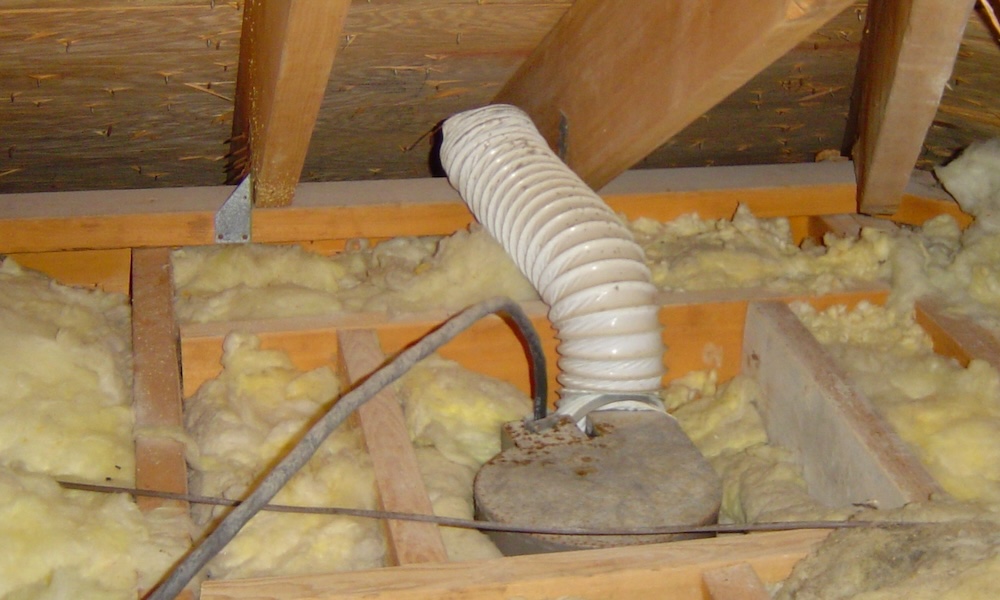
Wrong! Attic ventilation works according to the principle of the stack effect. Air comes in through the soffit vents and exits through vents higher up on the roof, either ridge, gable, or roof deck vents. That air coming in at the soffit will just push the bathroom air back into the attic. No good.
At a dead end
Here’s an interesting one I saw in South Carolina. The installers didn’t know where they were going when they started with that duct below. When they hit an obstacle, they just stopped.
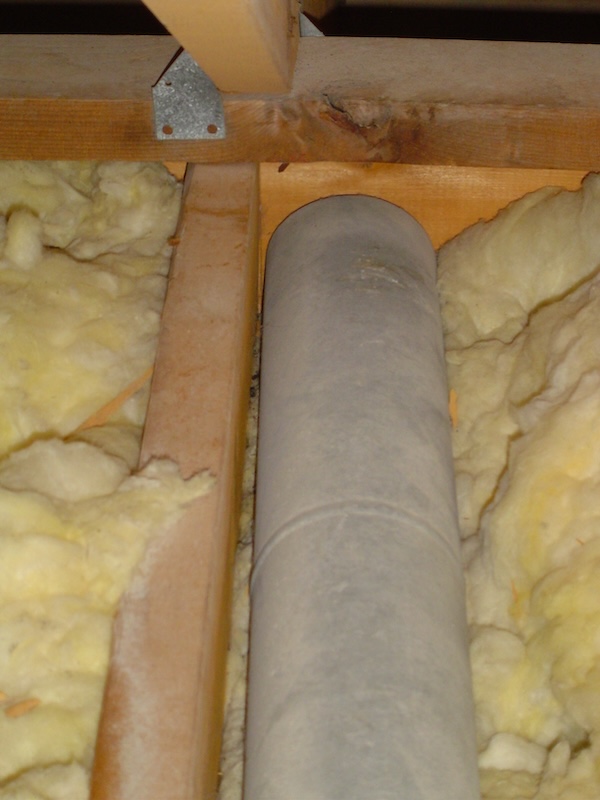
How much air do you think that bath fan moves?
No duct at all
And then there’s the case of the duct that wasn’t there. I’ve seen quite a few ductless bath fan in attics.
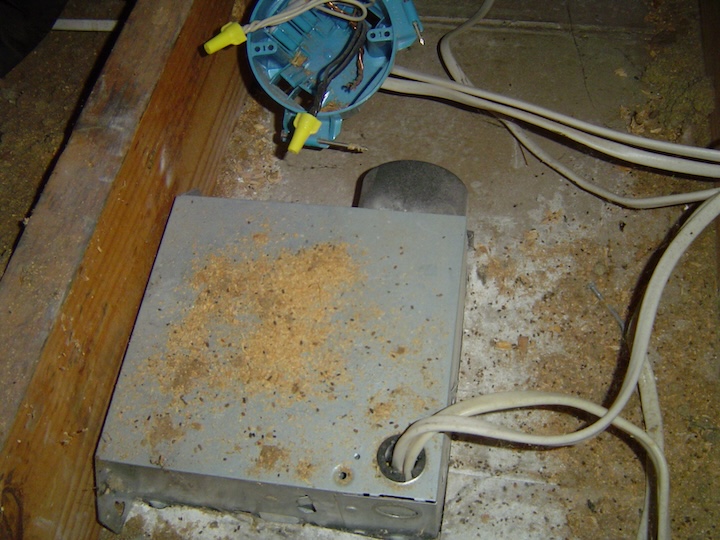
At least the one below has some (completely unnecessary) filtration through the fiberglass.
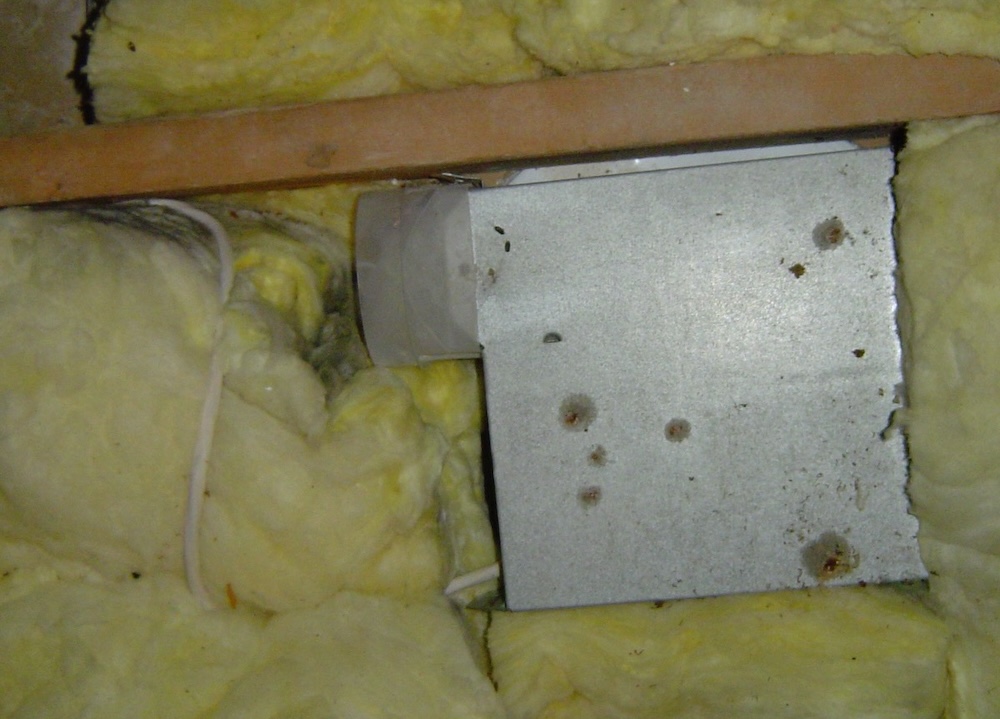
Ductless can work fine for heat pumps. Don’t try it with bath fans, though.
A DIY retrofit
Here’s another doozy. It looks like someone tried to get the bath fan to exhaust upward into the attic by moving the blown insulation away and setting a downspout elbow over the outlet. Hmmm.

I give credit to them for good intentions, but that’s not gonna work.
How bad could it be?
Moisture damage in an attic can be severe. Of course, mold needs water to grow, so you can create some serious indoor air quality problems. The moisture also can rot the framing and roof decking. I recently heard from someone who had to replace their whole roof prematurely because of this very problem. So, just a little missing ductwork on their fans resulted in a $16,000 repair and roof replacement.
Another problem sometimes occurs as well. Before we bought our house from my father-in-law, he had the attic encapsulated with spray foam insulation. Within a year or so, he had to get another company to come in and do some remediation because he had mold growing in the attic and on the hallway ceiling. Part of the problem was that the bath fans vented to the attic.
Where should duct go?
A duct on a bathroom exhaust fan needs to terminate so that the exhaust air goes all the way to the outdoors. That could be through a roof, a gable end, or a soffit. And yes, it can work to exhaust the air through a soffit, despite what I said above about air coming in at the soffits. The key is to make sure you have ducting and a termination that all the air to exit at a high enough velocity to escape any drafts that occur for attic ventilation. I wrote about that when I installed an exhaust fan in a bathroom remodel a while back.
So, have you checked out your bath fans yet?
____________________________________________________________________
Allison A. Bailes III, PhD is a speaker, writer, building science consultant, and the founder of Energy Vanguard in Decatur, Georgia. He has a doctorate in physics and is the author of a bestselling book on building science. He also writes the Energy Vanguard Blog. For more updates, you can subscribe to Energy Vanguard’s weekly newsletter and follow him on LinkedIn. Photos courtesy of author, except where noted.
Weekly Newsletter
Get building science and energy efficiency advice, plus special offers, in your inbox.















11 Comments
Maybe this is a dumb question, but isn't it against code to vent a bathroom to an attic? Like, isn't the whole point of a vent to get the air/moisture *out* of the house?
David, there might be some jurisdictions where it isn't required, but it is included in IRC M1505.2.
It probably varies, but with our subs this is one of the less obvious areas of scope gap where the electrician installs the fan, and roofers install the vent cap, but its left up to the GC to connect the two. Especially with it being out of sight it is one of the easier things to miss.
I'll add it to my checklist of things to review in my build, thanks.
bcade,
" ...but its left up to the GC to connect the two."
That's one of the things I've seen owner/builders (or absent GCs) struggle with. They often assume the role just involves coordination of trades, but here are a number of tasks that fall in between the expected scope of subs work than are the job of the GC to do.
I just searched FHB and GBA and was surprised to see there aren't any articles directly addressing scope gap. Perhaps there's a different term for it? If not, this would make for a great article topic.
bcade,
Agreed.
What is a score gap? That's not a term I'm familiar with.
David,
Our code precludes exhausting air into or drawing air from an attic for either ventilation or for appliances.
It is now, but many existing homes have this system in place (accidentally or on purpose.) In my 1983 townhouse, the bathrooms all vent into the attic. And while the attic itself is passively vented with slots allowing atmospheric air to pass in/out, it's an outdated method for sure. We often get away with it because I'm in Phoenix which is super-dry, but even the Dept. of Energy tells homeowners on their website that before doing any attic or insulation upgrades, they have to remedy any exhaust fans into the attic.
It's worse with kitchens and dryers because grease and lint, respectively, can become a major fire hazard.
I see this often in Minneapolis, 3" noisy bath fan ducted into the attic. The last time was on my neighbor's house built in 1977, replaced with Delta Breeze fans vented outside of the roof.
Doug
The vented air will be replaced by outside air in the common, leaky home. In the winter, the outside air is cold and dry and needs to be not only heated but humidified. In summer, the makeup air will be hotter and may in certain climates hold more absolute moisture content, both of which again require conditioning. Given the energy cost, wouldn't it make more sense to vent bathroom air elsewhere in the conditioned space? Put another way, we only need a bathroom vent to remove moisture because the bathroom door is closed. The bathroom vent is a simulated open door. Of course, if the purpose for the vent is to remove odors, the vent should terminate somewhere neutral, i.e. not my bedroom.
Log in or create an account to post a comment.
Sign up Log in